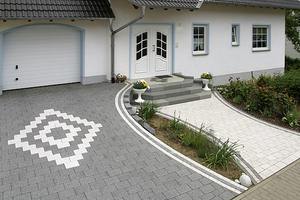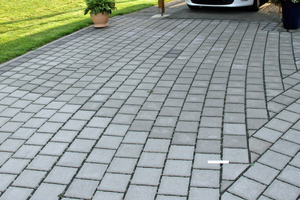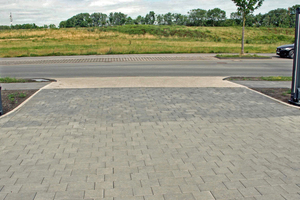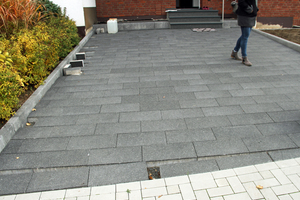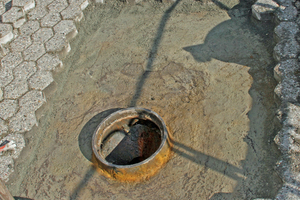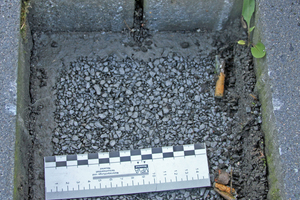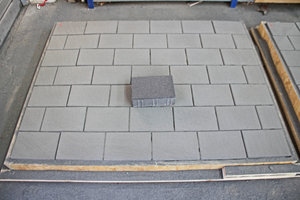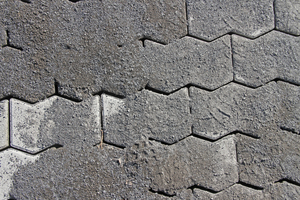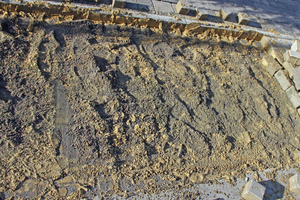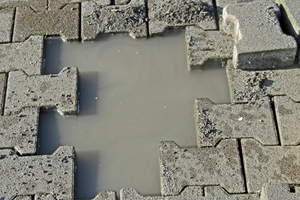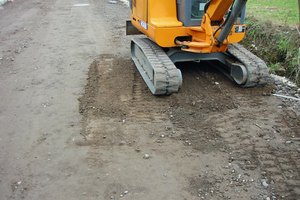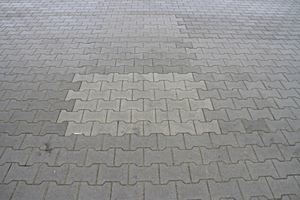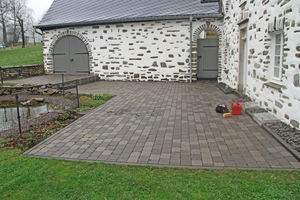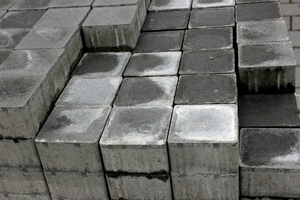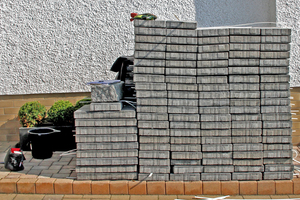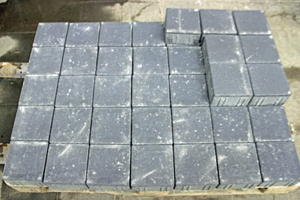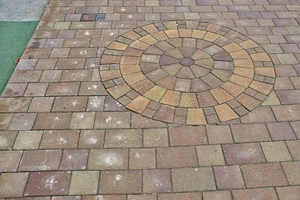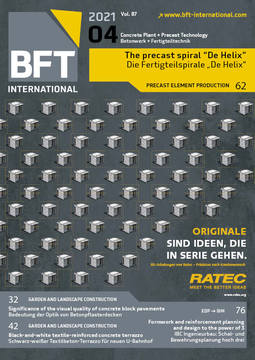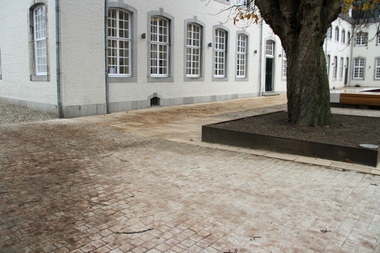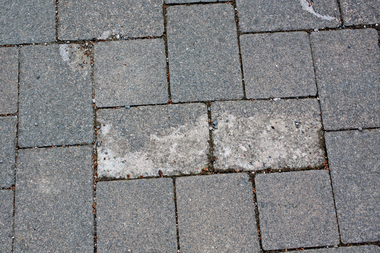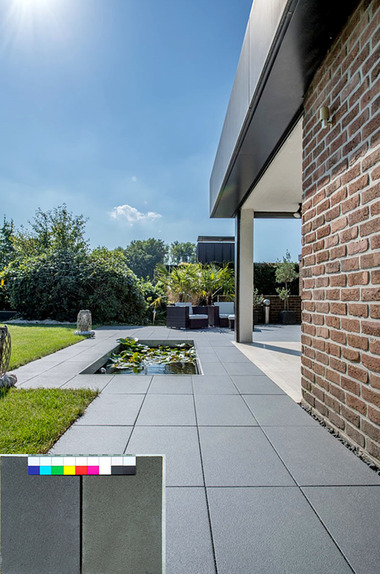Significance of the visual quality of concrete block pavements
During the past few years, the visual quality of concrete block pavements has become increasingly important because driveways and terraces are increasingly considered to be signature pieces of the building. In line with this trend, the number of complaints arising from visual deficiencies of block pavements due to a wide variety of reasons has also been growing.
1 Introduction
During the past few years, the visual quality of concrete block pavements has become increasingly important because driveways (see Fig. 1) and terraces are increasingly considered to be signature pieces of the building.
In line with this trend, the number of complaints arising from visual deficiencies of block pavements has also been growing. Such deficiencies can be due to a wide variety of causes. A design and site supervision process aligned with these visual quality requirements can considerably reduce the risk of, for instance, color deviations between the selected products or color variations visible within a single block pavement. Analyzing relevant legal disputes reveals that the following factors are the primary causes of block pavement discolorations:
Color irregularities between delivered products (see Fig. 2a; Section 7.1 of [1] contains the related explanations)
Discoloration of paving blocks owing to the use of “discoloring” loose joint-filling materials (see Fig. 2b and the explanations contained in Section 7.2 of [1])
Efflorescence appearing on the pavers’ surface (see Fig. 3a and the related explanations in Section 6 of [1])
Discolorations caused by the detachment of surface coatings in the case of coated block pavements (see Fig. 3b and the related explanations in Section 5 of [2]).
2 Measures to ensure the visual quality of block pavements
The following sections of this article provide detailed guidance on the measures to be implemented in the planning and design as well as site supervision phases in order to reduce the risk of causing visual deficiencies of the block pavement.
2.1 Planning and design
2.1.1 Water permeability
Any appropriate installation of block pavements requires all subgrades, base and bedding courses to be designed such that their water permeability is ensured. If this is impossible, the design should include appropriate measures allowing for the damage-free discharge of water that has made its way into the pavement structure, such as by including an appropriate arrangement of drainage systems.
This means that designers need to specify water-permeable subgrades or base courses that must be installed using certified materials. If this is not desirable or possible, separate measures should be implemented in order to ensure appropriate drainage. This is the case, for example, if a block pavement is laid onto a bonded base course, such as on an underground car park (see Fig. 4) or on a concrete foundation slab of a terrace.
Disregarding these requirements will increase the risk of rutting as well as edge spalling and freeze-thaw damage to the pavement. Likewise, the risk of efflorescence occurring on the paver surface will also increase because any water that has penetrated into the structure will evaporate upwards (i.e. through the paving blocks) while transporting the calcium hydroxide causing the white bloom to the pavement surface (see Section 6 of [1]).
Yet another factor with a major influence on the water permeability of the base course, and thus on the susceptibility of the pavement to efflorescence, is the selection of the bedding and joint-filling materials. In this regard, care must be taken to ensure the filter stability of the joint-filling and bedding materials in relation to each other. What is even more important, however, is the use of joint fillers and bedding materials with a sufficiently high particle strength. In the case of an insufficient particle strength of the mineral aggregates, the aggregates will be “ground” within the structure when driving over the block pavement, resulting in the formation of a layer with insufficient water permeability underneath the pavement (see edge area in Fig. 5). The water that has previously penetrated into the pavement structure will then accumulate on top of the water-impermeable layer, causing the pavement to “float” when subjected to vehicle traffic and accelerating damage progression even further.
2.1.2 Selection of joint fillers and final cleaning
Besides the filter stability of joint fillers and bedding materials and the particle strength of mineral aggregates, the selected joint-filling materials can also directly influence the appearance of the block pavement owing to their susceptibility to discoloration. For instance, it has long been known that even loose joint fillers can cause a significant discoloration of the pavement surface (see Section 7.2.1 of [1] and Fig. 6).
Thus, the designer’s most effective approach to reducing such color deviations is to convince the customer not to use pavers in a uniform or dark shade as far as reasonably possible. Such uniformly colored, dark (often anthracite) block pavements should be viewed very critically with regard to the visibility of discolorations because such products will exhibit discolorations with a much more pronounced pattern and thus greater visibility compared to pavers in bright or nuanced shades.
Furthermore, designers should specify an appropriate final cleaning step in order to reduce the risk for such discolorations to occur. A wet method should be applied for cleaning as early as possible (i.e. no later than three days after installation of the pavement). The common practice of leaving joint fillers on the pavement for an extended period, as shown in Fig. 7, should also be viewed extremely critically with respect to the susceptibility of the pavement to discolorations.
Since the susceptibility of block pavements to efflorescence increases with the time of contact with water, joint fillers with a very high water retention capacity also pose a relatively high risk of generating visual deficiencies on block pavements. In this context, joint fillers with a higher fines ratio and small maximum particle size appear to be rather problematic (see Fig. 8).
2.2 Site management and supervision
2.2.1 Water permeability of the subgrade
It is crucial to ensure the water permeability of the base course or subgrade (see Fig. 9) also when installing the block pavement. For instance, the subgrade needs to provide a sufficiently high water permeability in order to minimize the susceptibility to tertiary efflorescence appearing in situ.
To mitigate such risks, care must be taken to ensure, during installation, that the amount of soiling accumulating on the subgrade with a “sealing” effect should be limited. In addition, vehicle traffic on the subgrade and the bedding of the pavement should be restricted during the construction phase in order to limit the degree of consolidation of the subgrade (see Fig. 10). If it is impossible to avoid such traffic, the consolidated course providing insufficient water permeability must be replaced prior to installing the block pavement.
2.2.2 Visual inspection and acceptance of delivered products
Paving blocks should generally be subjected to visual inspection prior to installing the pavement. Pavers exhibiting significant color deviations, variations or discolorations should not be installed in order to keep the potential damage or deficiencies to a minimum. If, at the time of delivery resp. installation, the pavers are found to be deficient in terms of their appearance, the contractor must not install such products, regardless of which party has caused the identified discolorations.
Installed pavements consisting of low-cost “industrial pavers”, for example, often exhibit a certain type of “checkerboard” pattern (see Fig. 11), which frequently gives rise to client complaints.
To reduce the risk for such a checkerboard pattern to occur, no equipment and machinery must be used for installing such pavements because the manual laying of pavers taken from different packs can contribute to achieving a more uniform appearance of the pavement.Irrespective of this approach, engineering consultants may also ask themselves whether industrial pavers are at all suitable for installing block pavements for which an exceedingly high visual quality has been specified. The primary purpose of industrial block pavements is to ensure the transfer of comparatively high loads into the course or element underneath. “No great emphasis” is usually put on the aspect of visual quality when developing and producing such types of pavers, which is also often reflected in the price levels of such products.
The quality of pavements having to comply with more sophisticated visual requirements is usually considered to be much more significant in terms of production (for instance by using other input materials or applying coatings as well as incorporating a more thorough sorting process) as well as storage (interim storage in roofed outdoor areas, using spacers between the product layers), which is why appropriate measures are implemented as part of the production process in order to ensure the specified visual quality. Industrial pavers are generally not subjected to such measures.
Should the client specify more sophisticated visual requirements for the pavement despite the use of industrial pavers, only those pavers should be used that the producer advertises as products of a “high visual quality”. Only in this case will producers usually take the necessary precautions (see above) in order to ensure the corresponding appearance. In addition, site management must ensure that the pavement is laid manually (excluding the use of any equipment and machinery) in order to mitigate the associated risks while also using pavers from a single batch. This is because the risk for color variations to occur will increase materially if pavers of several batches or deliveries are used. Accordingly, the total quantity of the blocks needed for installing the specified pavement with increased visual requirements must be ordered, delivered and properly stored on the construction site at the same time.
Unfortunately, the paver quantities ordered for pavements conforming to a high visual quality standard are sometimes insufficient, thus requiring subsequent deliveries of pavement blocks. It is thus usually impossible to avoid considerable color variations if pavers are delivered from a number of different plants rather than from a single source (see, for example, Fig. 12). If the quantities of pavers ordered are sufficiently large, it is crucial to ensure appropriate storage conditions on the construction site if the blocks need to be stored for an extended period in order to reduce the risk of unsightly secondary efflorescence to occur (see below).
Besides production-related color variations, paving blocks may also exhibit a significant amount of primary or secondary efflorescence prior to installation (see Fig. 13). In such a case, the contractor must discard such pavers during installation. In this context, it should be noted that secondary efflorescence can also be the result of inappropriate storage of the paving blocks on the construction site (see Figs. 13 and 14; this is the responsibility of the installation contractor or client). Besides paving blocks showing color variations or white bloom, products damaged during transport or exhibiting other types of discoloration must also be rejected prior to installation (see Fig. 15).
2.2.3 Vibration marks
Marks or stains caused by vibratory compaction during the installation process can also significantly impair the visual quality of the pavement. The risk for vibration-induced staining to occur can be reduced by using a paving pad (shown in Fig. 16) to protect the paving blocks. If no such pad is used, it will be impossible to prevent the corresponding “vibration marks” (see Fig. 17) from occurring.
2.2.4 Final cleaning
As discussed in Section 2.1.2, a wet method must be applied for cleaning the block pavement upon completion in order to remove discolorations caused by joint fillers, for example, as early as possible. In a research project conducted at the Neuwied materials testing facility, the use of so-called terrace cleaners (low-pressure surface cleaners) proved to be beneficial. Site management must ensure timely wet cleaning upon completion particularly if visually appealing pavements are installed, which is the only option for ensuring an appropriate visual quality of signature block pavements (particularly if dark shades are used).
3 Summary
The increasing significance of the visual quality of block pavements also has considerable repercussions on the planning and design as well as supervision of the installation of high-quality paved surfaces. Only if the design and site management process is aligned with the visual significance of the pavement will it be possible to ensure compliance of the block pavement with the sophisticated visual specifications.
The planning and design process concentrates on ensuring water permeability of the subgrade or base course as well as on selecting appropriate joint-filling materials. In addition, wet cleaning of the pavement upon completion should be specified.
In the past few years, we have unfortunately seen many pavements installed on construction sites without the regular presence of site supervisors (if provided for at all) even in the case of sophisticated visual specifications. There is thus a growing number of disputes on the grounds of visual deficiencies of block pavements. If site supervisors are present on a regular basis, they will be able to thoroughly check and improve the standard of workmanship. Site management should particularly concentrate on verifying the water permeability of the subgrade, visually inspecting delivered products, ensuring appropriate vibratory compaction, and closely monitoring the final cleaning process.
Implementing the above measures will not only significantly enhance the visual quality of signature pavements; it will also optimize the standard of workmanship of the block pavement and, more generally, its durability.
REFERENCES/LITERATUR

